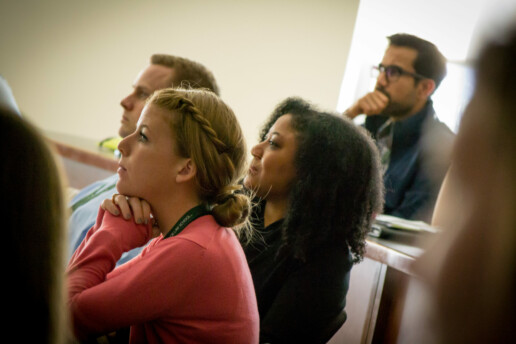Guest Post: Penalizing Preventative Mental Health Treatment for Law Students
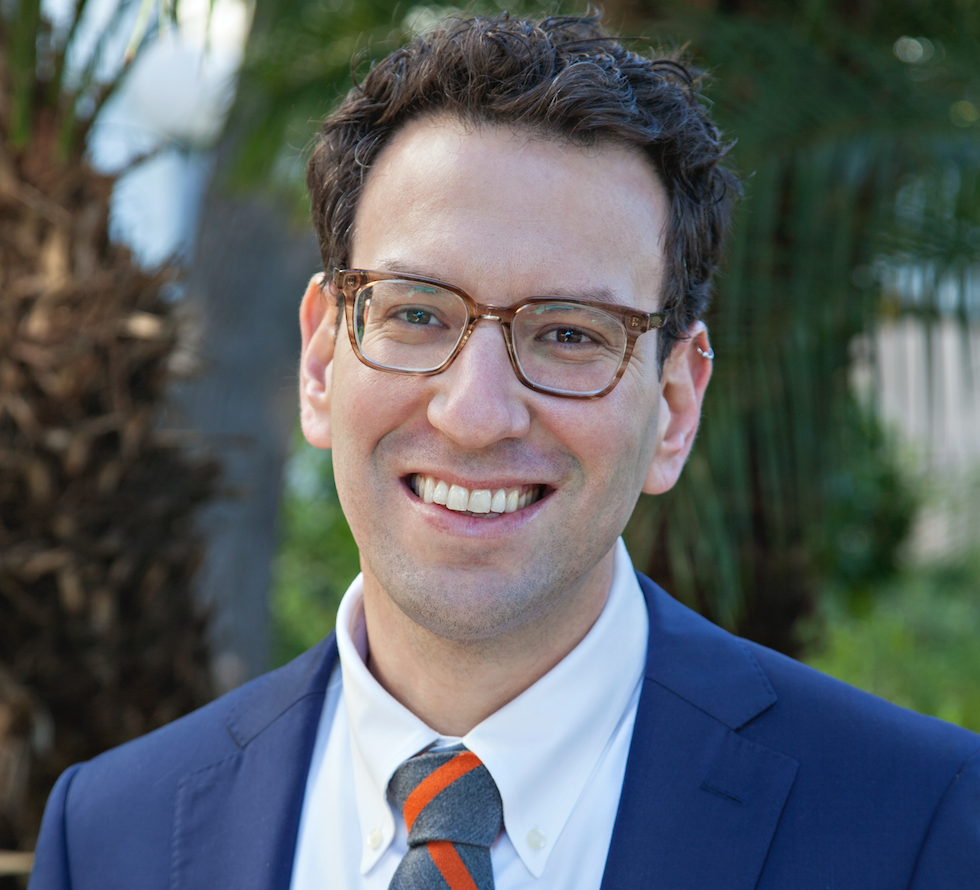
Guest Post: Penalizing Preventative Mental Health Treatment for Law Students
Doron Dorfman
Associate Professor of Law
Syracuse University College of Law
The study of mental health of law students can be traced back to the late 1960s when research published in the Wisconsin Law Review found that “failure anxiety” has been a serious impediment for first-year law students’ ability to study. Research from the 1980s all the way to 2016 has shown that the stress and anxiety is not only a problem found among 1Ls, but also one that continues throughout the law school journey.
It has been known for decades that attending law school is an extremely stressful experience. As recent LSSSE data demonstrate, attending law school remains stressful and anxiety provoking. A 2020–21 LSSSE survey module based on a sample of more than 2,000 law students shows that 77% percent of the students surveyed found the level of stress and anxiety in law school to be a 5 or higher on a 7-point Likert scale.
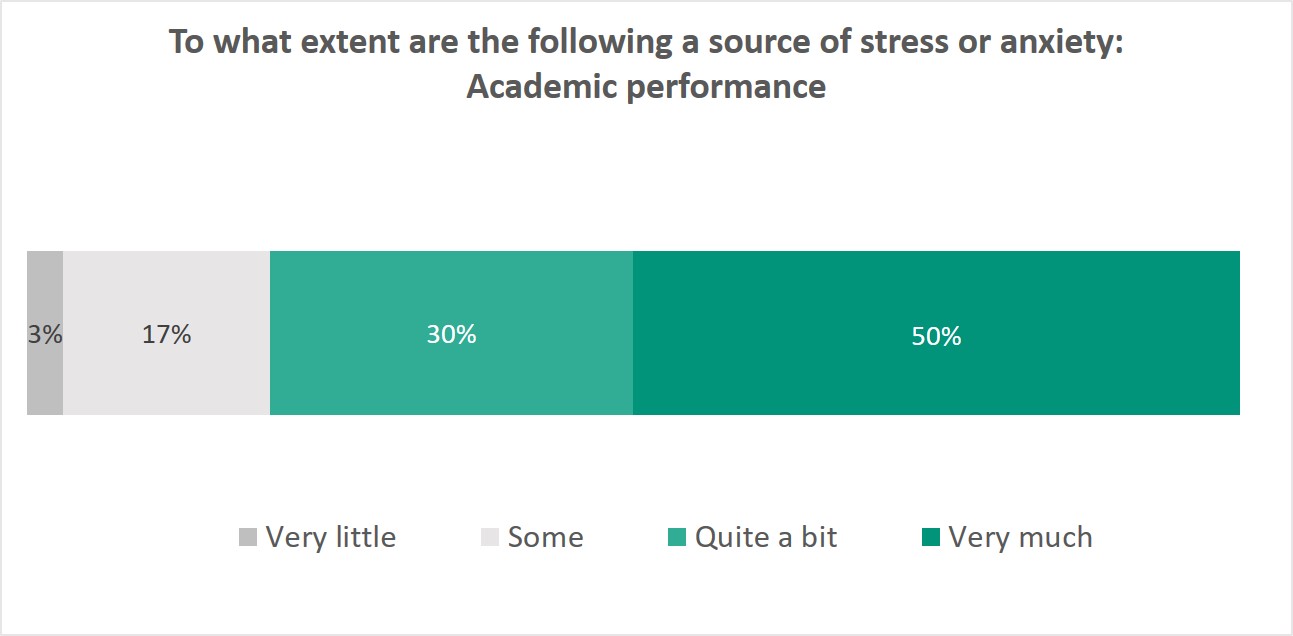
Much like the peers from 50 years ago, 50% of the sample say that the source of their stress or anxiety is “very much” due to concerns about academic performance.
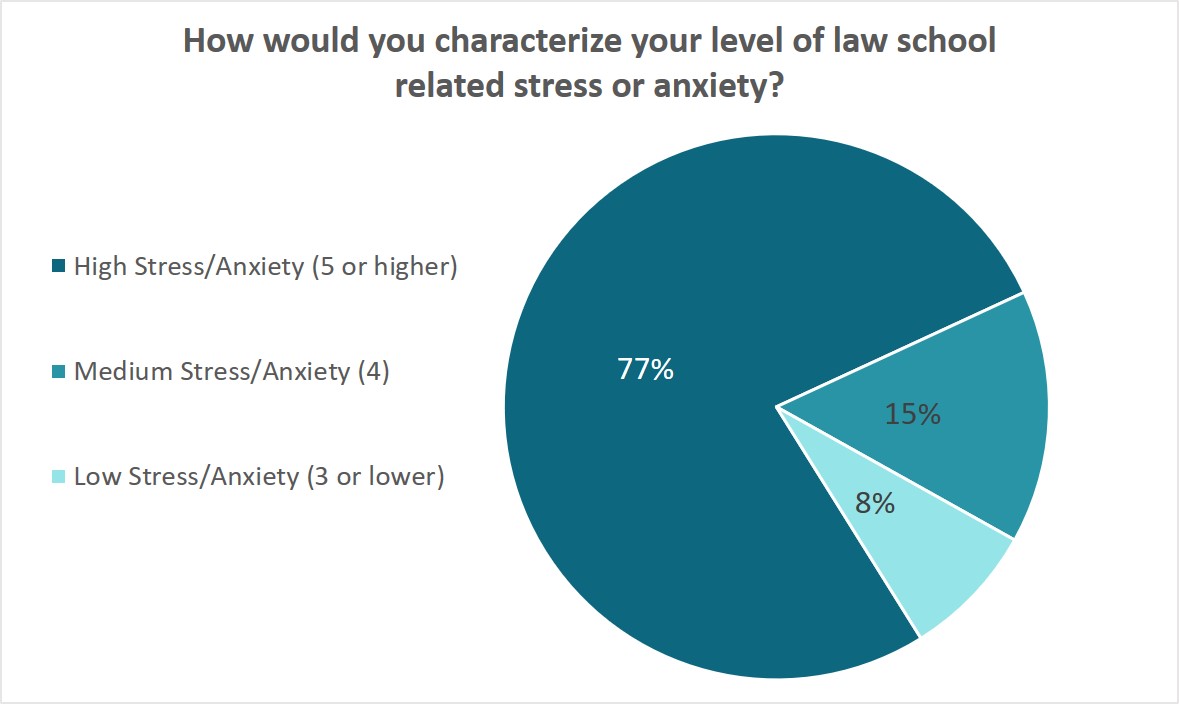
In a new research project, I examine what I call the “the paradoxical legal treatment of preventative medicine” showing how while the law on the books, specifically the Affordable Care Act, contains avenues to promote and encourage preventive medicine, those efforts clash with other policies and decision-making processes that in action penalize those who take preventative measures. This contradiction creates a chilling effect on those trying to take preventative health measures and impedes the ACA’s original goal of promoting this important tool to foster the quality of health care.
One of the examples of this phenomenon is the Character and Fitness evaluations state bar associations conduct around the country, used to admit prospective lawyers into the bar. These evaluations take into account the students’ mental health history. In a 2016 study, it was found that the number one reason for students not seeking mental health treatment, which can be classified as “secondary prevention,” one that is practiced after the illness has been diagnosed but before it has become symptomatic, is the potential threat to bar admission.
As one law student recently acknowledged, he refused to seek out mental health resources when law school stress was becoming too much, as he did not want to risk being flagged during the state bar’s Character and Fitness evaluation. Instead, he developed a drinking habit to relieve his stress.
As I trace in my new work-in-progress over the last 30 years since its enactment, the Americans with Disabilities Act limited the inquiries state bar associations can make in regard to a candidate’s past mental health treatments. Some courts have also adopted a behavioral approach, whereby prior mental health treatments, and even current counseling, do not in and of themselves deem a person unfit to practice law if no present behavioral issues exist. Yet the problem of penalizing preventative mental health treatment in the context of state bars’ character and fitness evaluations persists in other states as indicated by a 2019 report by the Bazelon Center for Mental Health Law.
Updated data on the mental health of law students, such as those collected by the LSSSE, are crucial for continuing the efforts to stop penalizing those seeking professional help for their stress and anxieties during law school. As I show in my work, it is another important arena in which the need to make sure the law promotes preventative medicine is particularly acute.
Ensuring that all state bars across the country find ways to balance the need to ensure applicants’ qualifications as competency and good moral character without penalizing and stigmatizing mental health treatment is a crucial goal that also holds the promise of diversifying the legal profession.
Guest Post: How Sending One E-mail a Week Helped Me Connect Better to My Law Students

Guest Post: How Sending One E-mail a Week Helped Me Connect Better to My Law Students
Jonah E. Perlin
Associate Professor of Law, Legal Practice
Georgetown Law School
Building connections with our students is one of the most valuable things we can do as law professors. Not only do these connections help us become stronger teachers, connection is also integral to our students’ success. As LSSSE’s “2018 Relationships Matter Survey” explained, “Law students who build strong connect ions with faculty, administrators, and classmates are more likely to appreciate their legal education overall and also have better academic and professional outcomes.”
But during the height of the COVID-19 pandemic when many law school courses including my own moved from the physical classroom to the digital world it became more challenging to create these connections. Gone were the informal chats in the hallway before and after class. Gone were the opportunities for a student to just “stop by” my office. Gone were the chance meetings in the cafeteria. Gone were so many of those regular but informal moments that help transform professor-student relationships from transactional to personal.
As the “Relationship Matters Survey” also reports a staggering 93% of law students believe that their instructors care about their learning and success in law school but the new reality required new pedagogical techniques to maintain this level of connection.

During the three semesters that I taught remotely, I tried several techniques to build this deeper personal connections with individual students and with my class as a whole. Some worked. Some didn’t. But what surprised me was that the single most successful tool to build connections with students in my first year course--and one which I continue to use even now that I have returned to teaching in-person--is sending a weekly takeaway e-mail.
Yes, you read that right. Writing one takeaway e-mail every Friday to my students has significantly improved my teaching and more specifically my connection to my students.
The Power of Takeaway E-mails
At first glance the proposal to send a weekly takeaway e-mail to law school students might seem at best unnecessary and at worst patronizing. After all, students in professional schools should be responsible for keeping up with class, completing their assignments on time, and identifying where they do not understand the material or need further assistance. More than that, receiving a newsletter-style weekly e-mail is a technique that many associate with elementary school teachers and local clubs or organizations.
Yet, as a consumer of remote, cohort-based online courses myself, I was surprised to learn that takeaway e-mails were common in online learning environments. These e-mails sent at the completion of class clarified what had been covered, previewed what was to come, and most of all gave me the sense that the instructors cared about my learning process. More than that, these e-mails felt like a free bonus class session that I could complete on my own time. From this experience as a consumer of online education, I decided that these asynchronous touch points would work just as well in my first-year Legal Practice course.
Now, after more than a year of sending weekly takeaway e-mails to my 1L students, I can say with confidence that takeaway e-mails make me a better teacher and, more importantly, help me build greater personal connection with my students for several reasons:
- More Regular Interaction. Students in my class have come to expect the e-mails and refer to them as they would class time. It is a fast, low effort, high impact way of connecting with students three times a week instead of only twice.
- Different Medium. Unlike classroom sessions which are largely conducted orally, the takeaway e-mail allows me to communicate with my students in a different mode of communication, the written word. It is often easier to articulate in writing lessons not just about the products I am asking them to create but also about the process of learning how to create those products. This helps students focus on the metaskills law school seeks to teach them: how to learn, how to deal with new tasks, and how to handle new problems that need to be solved.
- Bigger Picture. The e-mail is a chance to contextualize and crystallize the content covered the prior week and how it fits into the larger trajectory of the course and what is to come. In my experience, students who see this bigger picture earlier are often more successful in the course.
- Less Administrative E-mail. Takeaway e-mails allow me to handle 99% of the administrative and logistical issues that used to consume so much of my time. Instead of receiving and responding to lots of one-off e-mails that get lost in the shuffle, the weekly e-mail provides a one-stop, centralized, and easy-to-find place for reminding students as a class of what we’ve done and what is to come.
- Personal Connection. These e-mails allow me to further connect to students on a personal level. In them I can tell my students what I am working on, why I assigned a certain piece of reading, or even about activities that I am looking forward to on the law school campus. It adds a human touch sometimes hard to convey from the front of a classroom.
- Shorten the Feedback Cycle. If I learn after class that there is a common question or point of confusion based on office hours or individual student meetings, I am able to easily address that question in the weekly e-mail before the weekend begins so that we can start the next session without needing to go backwards.
I have learned from experience that a weekly takeaway e-mail is not only not patronizing to our students, it instead treats them like professional adults and with respect. Instead of sending one-off e-mails whenever I think of something I might want to share, they now look for one e-mail a week with exactly what they need. This allows me to model professional behavior while keeping my students apprised of key information that they need to know in a predictable and concise fashion.
What My Weekly E-mail Looks Like
An effective weekly takeaway e-mail can use any format. That said, the two keys to success in my view are (1) consistent organization and (2) consistent timing. These touchstones allow for takeaway e-mails that are more easy to create and more easy to consume. I personally use our Learning Management System (Canvas) to send the takeaway e-mail as an “Announcement” so that it is sent by e-mail but also stored on the class home page and can be viewed at any time. Each week my e-mail begins with a statement about where the students are in the course (and in their first-year education). This adds context to the educational moment on their journey. It then includes a brief recap of each class meeting in the prior week and a section on the deadlines and topics that will be covered in the week to come. Then it contains additional sections, as needed, about substantive areas that we covered in class, answers to frequently asked questions, or information about exciting events on campus or articles that I want to draw their attention to. To make it easy to read on mobile devices I use section headings with content-relevant emojis so it is easy to skim (for example, ✅ Assignments). And the best part of all is that because the flow of my course is similar year-to-year, large parts of the e-mail can be reused in future years helping leverage that initial investment of time in my future teaching.
But Really? E-mail.
Yes. For better or worse we live in a society in which information is conveyed by e-mail. One benefit is that we can build connections by e-mail that we are unable to build in limited in-person experiences--and those connections can be built asynchronously and from our own homes. We can use this tool as professors in a way that inspires deeper connection and models professional behavior as opposed to a tool that creates a constant stream of ad hoc information. In less than 30 minutes a week, this one technique has allowed me to build deeper connections with my students, spend less time responding to individual questions, and model a culture of learning and accountability in my classroom.
Guest Post: Student Response Systems as a Tool for Formative Assessment
Guest Post: Student Response Systems as a Tool for Formative Assessment
Hannah Haksgaard
Associate Professor
University of South Dakota Knudson School of Law
Under American Bar Association Standard 314, law schools—and therefore individual law professors—are required to engage in formative and summative assessment of students. Formative assessment is assessment that occurs during the semester where students receive feedback in order to improve their performance. Although formative assessments do not need to be graded, formative assessments must include feedback that is detailed and on point. Feedback on formative assessments is most valuable if it can be provided promptly. Yet, under half of the LSSSE respondents report receiving prompt feedback from faculty “often” or “very often” on academic performance.
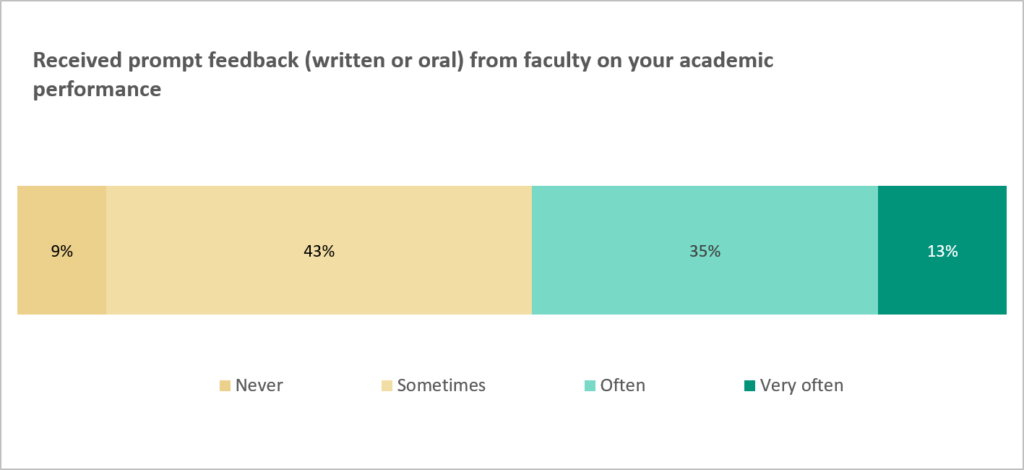
However, this student response may be undercounting formative assessments. Professors give immediate feedback in all sorts of ways that students might not recognize, such as through a Socractic dialogue in class, through brief conversations in hallways, and through feedback on group discussions during class. More formal feedback—such as graded quizzes or written comments on drafts or practice exams—is time-intensive for professors and can be especially burdensome for professors with large-enrollment courses or high service loads.
One way to provide fast feedback on student performance is to use student response systems in the classroom. Traditionally operated through hand-held clickers, student response systems are now internet-based programs that allow professors to pose multiple-choice or true/false questions on the screen and students to answer those questions on their phones or computers. Programs include Kahoot!, Mentimeter, Poll Everywhere, Socrative, Turning, and many others.
Importantly, these programs provide immediate feedback to students. Once all of the students have answered a question, the correct answer is highlighted on the screen. Plus, each student’s own device tells the student whether they were right or wrong on that question. In addition to providing feedback to students about their own individual performance, these programs show what percentage of the class chose each answer. This allows students to recognize how they are performing in comparison to peers and allows professors to modify their teaching based on the responses received.
During the COVID-19 pandemic, law professors and law students have been forced to adopt more technology in teaching and learning. Student response systems are an important way to leverage technology whether for in-person, hyflex, or online teaching. According to the LSSSE, most students feel their schools emphasize using technology in academic work.
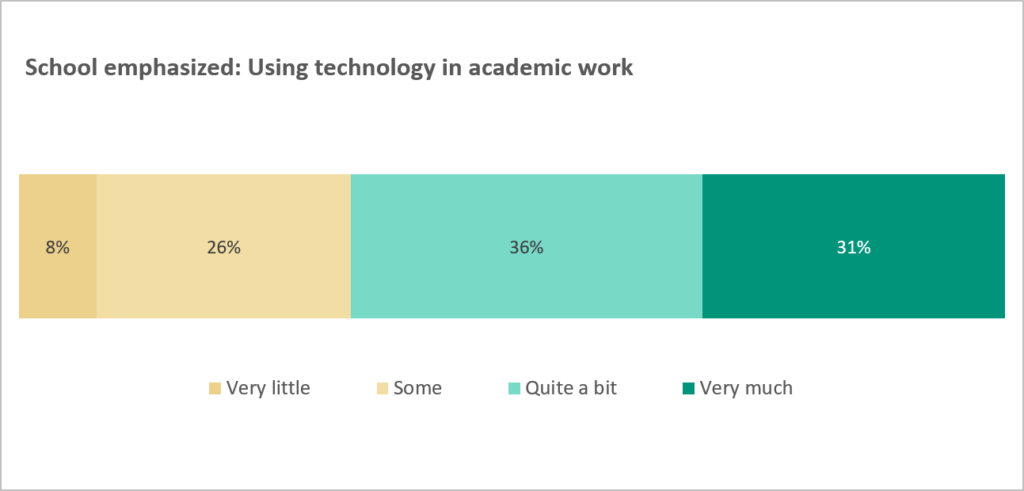
Student response systems are a way to emphasize the use of technology in the actual classroom in order to improve student learning and student participation. This is particularly important for Generation Z law students—those born between 1995 and 2010—who already make up a majority of law students, having now replaced millennials as the dominant generation in law school.

Research shows that Generation Z students expect to receive information quickly and have trouble disconnecting from cell phones.[1] Using those cell phones for in-class activities through student response systems can both engage law students and provide them the immediate feedback they seek.
This technology will never replace substantive written feedback or one-on-one meetings to discuss assignments, but student response systems are a way to supplement other assignments and types of feedback. Both students and professors benefit from formative assessment, and student response systems are an easy way to provide the immediate feedback that students need.
__
[1] Tiffany D. Atkins, #ForTheCulture: Generation Z and the Future of Legal Education, 26 Mich. J. Race & L. 115, 135 (2020).
Guest Post: A Message to White Law Faculty: Mentor Racial Minority Students
 Guest Post: A Message to White Law Faculty: Mentor Racial Minority Students
Guest Post: A Message to White Law Faculty: Mentor Racial Minority Students
Gregory S. Parks
Associate Dean of Strategic Initiatives and Professor of Law
Wake Forest University School of Law
Pursuant to Law School Survey of Student Engagement’s (“LSSSE”) 2020 Diversity and Exclusion Annual Survey, there are troubling findings with regard to racial minority students’ sense of belonging and institutional support. Thirty-one percent of White students, but only 21% of Black and Native American students, feel a part of their law school community. Moreover, “women of color are more likely than men from same ethnic/racial backgrounds to feel that they are not part of the campus community.” Specifically, 34% of Black women law students felt this way. When asked if they did not feel comfortable being themselves on campus, 12% of White students agreed compared to 21% of Black, Latinx, and Native American students. Students of color are more likely to believe that their school does “very little” to ensure they are not stigmatized based on identity characteristics. Twenty-five percent of Black, 18% of Latinx, and 14% of Native American students—compared to 9% of White students—agree with the statement.

When it comes to perceptions of institutional support, 32% of White students believe that their school does “very much” to support diversity compared to 18% of Black students. Correspondingly, 26% of Black women, 14% of Black men, 8% of White women, and 6% of White men believe that their school is doing “very little” to create an environment to support diversity. In addition, 28% of White students feel like their school does “very much” to support community among students while 18% of Black students and 14% of Latinx think their school does “very little.” Not surprisingly, only 31% of Black men, 18% of Black women, 32% of Latinx men, 23% of Latinx women, 31% of White men, 26% of White women, 25% of Asian American men, 23% of Asian American women, 27% multi-racial men, and 23% multi-racial women strongly agree that they feel valued by their institution.
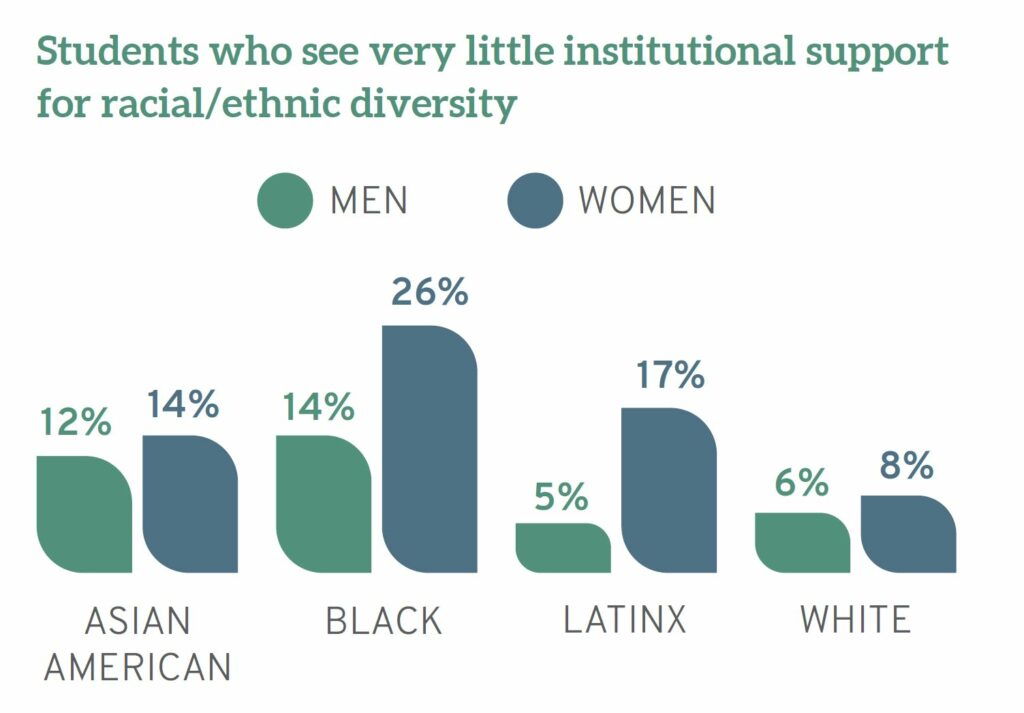
Faculty of color often shoulder a disproportionate amount of emotional labor in supporting students of color.[1] As such, White law faculty can and should play a meaningful role in making the law school experience one where racial minority law students feel a greater sense of belonging and institutional support. That is through mentoring. Mentoring has two distinct functions—professional and psychological. Professional mentoring aids the mentee in advancing in the workplace. Psychological mentoring seeks to bolster the mentee’s competence, effectiveness, and identity. Mentoring relationships are rooted in clear expectations, mutual respect, personal connection, reciprocity, and shared values. Within the context of cross-racial mentoring relationships, mentors must be proactive in building a foundation of mutual respect and trust. In doing so, the mentor must develop cultural awareness and sensitivity to cross-cultural issues.
As such, mentors must:
- Recognize their own privilege.
- Have a growth-mindset in the relationship.
- Empathize with their mentee where possible.
- Listen to understand when they cannot.
- Guide the mentee to their own fullest potential.
- Diversify their own viewpoints and knowledge to become more informed on issues that may not affect them.
It takes work to be a good mentor. But it pays dividends for the mentee, mentor, institution, and legal profession. Law faculty have a lot on their plate. And while it is unreasonable to think that law faculty, in the aggregate, can mentor every law student at their school, the truth is that we can likely do much better than we are doing. And given that racial minority law faculty often carry much of the emotional labor associated with supporting the most marginalized law students, White colleges can and should play a much more significant role in this effort.
___
[1] See Meera E. Deo, Unequal Profession: Race and Gender in Legal Academia (2019)(note chapters 3 and 4).
Guest Post: Bridging Global Divides in Law School and Beyond
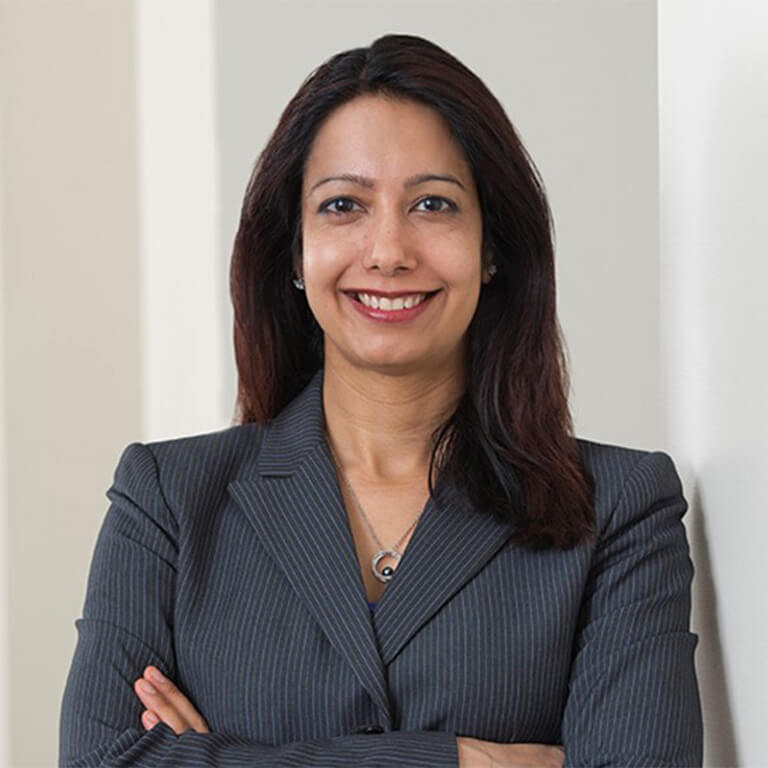 Guest Post: Bridging Global Divides in Law School and Beyond
Guest Post: Bridging Global Divides in Law School and Beyond
Shruti Rana
Professor International Law Practice
Assistant Dean of Curricular and Undergraduate Affairs
Director of the International Law and Institutions Program
Hamilton Lugar School of Global & International Studies
Indiana University Bloomington
International law is a growing and dynamic field, offering students a launching pad into a variety of careers spanning sectors from government to private practice to non-profit or advocacy work. Lawyers and advisors trained in international law have opportunities to address some of the most pressing global challenges of our time, and to build bridges through trade, business, migration, communications or capacity-building work. Careers in this field can be groundbreaking and even glamorous—notable international lawyers include Amal Clooney, Shirin Abadi, and Samantha Power.
Not surprisingly, then, international law is a popular choice for students entering law school—1L students rank international law as one of their top 10 areas of intended specialization. However, as they progress through law school, students’ interest in international careers drops steadily over time, and by graduation, international law drops down to sixteenth place in terms of student interest. These drops are especially striking for women and students of color, who initially show more interest in international law than other students yet appear similarly disillusioned by law school’s end. These trends are even more alarming for the legal profession and our nation as a whole when we consider that although “decades of research and experience prove that diversity strengthens decision-making, promotes innovation, and brings new, critical perspectives to global challenges,” women and people of color are greatly underrepresented in these global careers.
The Law School Survey of Student Engagement (LSSSE) offers some intriguing data on the question of why U.S. law students turn away from international law over time. The data also provide clues as to where the key gaps in U.S. legal education are with respect to international law, and the impact of these gaps on students’ inclusion and opportunities in law school and beyond. They offer an important starting point for leaders in legal education to consider in developing programs and perspectives that cultivate and support students interested in careers in international law. Ultimately, addressing these gaps can help create more inclusive environments for all students, as well as foster the development of the global competency skills that are increasingly critical for any legal career.
Beginning with the students themselves, LSSSE data show that students who express interest in and stick with international law as a career choice differ in striking ways from students who do neither. In terms of student diversity, there is a marked gender divide in interest in international law, with women comprising 64.8% of the students interested in pursuing international law. Overall, 7% of the women entering law school are interested in international law as compared to 5% of men. Students interested in international law are also more diverse in terms of race and ethnicity than students who are not, with Asian American students in particular significantly more interested in international law.

Students interested in international law are often advised to look outside of law school to develop the language, policymaking, and cultural competence skills they will need to understand the mechanisms of global governance and operate in diverse global environments. LSSSE’s data show that students interested in international law do just that. While in law school, students interested in international law are more than three times more likely to pursue a joint LLM or MA degree than students not interested in international law, perhaps to obtain global skills not traditionally taught in J.D. programs (34.8% of students interested in international law are pursuing a JD/MA, and 27.0% are pursuing a JD/LLM as opposed to 9.3% and 9.8%, respectively, of students not interested in international law). However, students who are interested in international law are about a third to one-half less likely than law students as a whole to pursue joint MBA or MS degrees. (13.5% of interested students pursue joint MBA degrees compared to 31.7% of non-interested students, and pursue MS degrees at roughly half the rate (4.5%) of students not interested in international law (8.1%). Perhaps because they must look elsewhere to develop the skills critical to international careers, students who express an interest in specializing in international law are also somewhat less satisfied with their law school experiences, as they are more likely to say that if they could start over again, they would probably not choose to attend the same law school they are now attending (18.6% of students interested in international law compared to 13.8% of students not interested in international law).
Looking beyond their law school experiences, students who express an interest in international law also show significantly different workplace preferences. As compared to students who do not express an interest in international law, they show a greater preference for government positions (15.6% vs. 10.5%), public interest groups (9.1% vs. 5.5%) and large firms over small (19.8% vs. 14.2%). They are also less interested in domestic criminal law (only 3.3% are interested working as prosecutors or public defenders, as compared to nearly 10% of students not interested in specializing in international law).
The differences delineated above correlate with and parallel larger trends in the fields of international law and global affairs. Although women make up an increasing percentage of students pursuing college and graduate education in law and the humanities, they are greatly underrepresented in professional careers in the international arena, where their perspectives and experiences are often devalued and marginalized. (See, e.g., Women in International Relations, Politics and Gender 4(1)(2008), and Do Women Matter to National Security? discussing survey results revealing the lack of women in leadership roles in these areas and in the priorities of these fields); see also The Emotional Labor of Teaching—A Feminist Critique of Teaching International Law discussing the marginalization of feminist perspectives in international law). It is likely that women both encounter these barriers to entry and general hostility to women in international affairs and institutions while in law school, and that these barriers are compounded by a lack of available mentors and visible representation in the field. The gendered impacts of these divisions are further amplified and mirrored when race, ethnicity, and the hierarchical and historical legacies of our current system of international law are added into the mix. The challenges of grappling with the colonial legacies of the current international order, or of addressing inequality through and within the field of international law, add to the already significant challenges of international careers.
It is likely that students begin (or continue) to encounter these perspectives and obstacles in law school, as international law and the language and cultural skills needed to pursue global careers are often marginalized within the legal academy. This marginalization is reflected in teaching and scholarship, the often negative perceptions of international LLM students in U.S. law schools (which LSSSE data has helped refute), and the contrasts with law schools outside of the U.S., where international law is usually a required subject. The international law arena is replete with the stories of people drawn to the field because of their experiences in the liminal, transformative spaces or social justice movements created in the wake of migration, development, war or the many other forms of global inequality—only to run directly into brick walls in law school when they encounter international law as “a discipline and a language that genuflects before the status quo” in ways that appear irreconcilable with goals such as addressing the causes and impacts of global inequality. Law schools, it appears, replicate rather than reduce the dynamics of inequality that first draw diverse students to law school, which then push them away from their careers of choice and the fields where diverse perspectives are so urgently needed.
The LSSSE data provide a valuable starting point for thinking about how we can continue to address the marginalization of international law in U.S. law schools, and its implications for students interested in international careers. We must support students in building global competency skills and the networks they need to break professional barriers, and foster an environment that equips them not to shackle but unleash the liberatory power of the law. At Indiana University, we have begun to take a number of innovative steps to address such obstacles, and create an inclusive environment focusing on the development of global skills to prepare students for careers in international law and global affairs. Our International Law and Institutions program, a joint endeavor between the Hamilton Lugar School of Global and International Studies and the Maurer School of Law, focuses on the hard and soft skills students need to pursue careers in international law and global affairs. These programs include intensive language training combined with in-depth regional experience and a focus on gaining a holistic understanding of the tools and mechanisms of global governance and civic leadership. They also include initiatives aimed at enhancing the diversity of the field of global affairs and providing the mentorship, training and networks students need to succeed in these careers. As the global challenges we face intensify and multiply, these and other efforts to enhance and prioritize the skills and experiences our students need to be “globally ready” can help build the foundations for a more inclusive and equal future.
Guest Post: Correcting the Diversity Skills Disconnect Using LSSSE Data
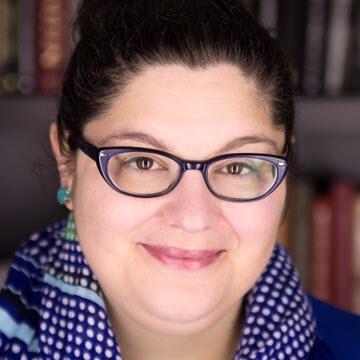 Guest Post: Correcting the Diversity Skills Disconnect Using LSSSE Data
Guest Post: Correcting the Diversity Skills Disconnect Using LSSSE Data
Nicole P. Dyszlewski
Head of Reference, Instruction, & Engagement
Roger Williams University School of Law
There is a disconnect within legal academia about diversity, inclusion, racism, sexism, equality, power, and social justice issues in law. There is a disconnect between faculty attitudes about the value of teaching diversity skills and the actual inclusion of diversity skills in law school doctrinal classes. This disconnect has existed for years. It exists in the hallways and the cafeterias, but it looms largest over law school classrooms. The disconnect has taken on a new urgency in the year since the murder of George Floyd (and countless other Black victims of police violence), since a year’s worth of historic protests against anti-Black violence, and since the demands made by student groups at many of our schools to change the status quo. Today I want to share some of my own experiences with this disconnect, talk about how LSSSE data can be used to inform our institutions about the disconnect, and introduce a book I have been working on in the last few years to help provide resources for those who want to teach 1L students about the roles that diversity, equity, and social justice play in shaping and practicing the law.
I have very rarely heard a law professor say that teaching about social justice, equity, and the needs of a diverse society is not important or not a good fit for the law school curriculum. While these naysayers exist, they seem to be very few in number. Most law professors I have encountered in person, in my networks, on law Twitter, or through their scholarship seem to think these issues are relevant if not critical in law. In fact, the council of the ABA's Section of Legal Education and Admissions to the Bar recently approved a revision to law school accreditation standards which would require schools to “provide training and education to law students on bias, cross-cultural competency, and racism: (1) at the start of the program of legal education, and(2) at least once again before graduation.” (See the current Notice and Comment).
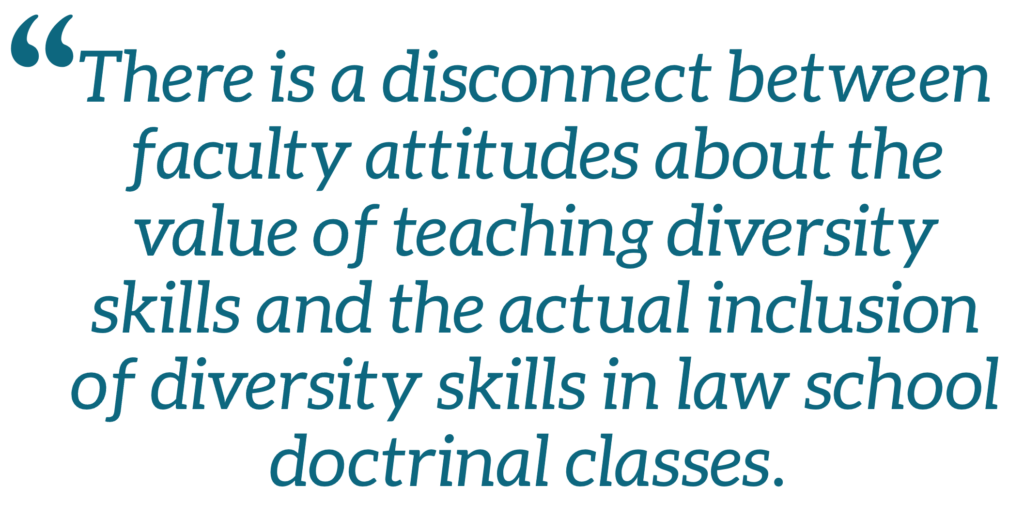 Despite wide agreement among faculty that these topics are critical in the law school curriculum, I have also observed a NIMBY-ism. I have heard faculty from several schools explain that there is too much content to cover in the semester and they can’t possibly add diversity issues to their class. I have heard professors say that diversity, racism, sexism, social justice, and similar issues don’t naturally come up in the class they teach so it wouldn’t make sense to add them. I have heard professors say they will not use any hypos or examples which confront these issues because they feel that the discussion would be too difficult to manage and take away from the “real” learning. While many of us agree that these topics are critical to the law school curriculum, fewer faculty find them critical to their own classes and their own teaching practice. There is a disconnect here between what we espouse and what we do.
Despite wide agreement among faculty that these topics are critical in the law school curriculum, I have also observed a NIMBY-ism. I have heard faculty from several schools explain that there is too much content to cover in the semester and they can’t possibly add diversity issues to their class. I have heard professors say that diversity, racism, sexism, social justice, and similar issues don’t naturally come up in the class they teach so it wouldn’t make sense to add them. I have heard professors say they will not use any hypos or examples which confront these issues because they feel that the discussion would be too difficult to manage and take away from the “real” learning. While many of us agree that these topics are critical to the law school curriculum, fewer faculty find them critical to their own classes and their own teaching practice. There is a disconnect here between what we espouse and what we do.
It is our students, particularly our students from marginalized and underrepresented communities, who are paying the price for this disconnect. As LSSSE Director Meera Deo stated in a recent report, “what the data unequivocally show, is that those who are most affected by policies involving diversity—the very students who are underrepresented, marginalized, and non-traditional participants in legal education—are the least satisfied with diversity efforts on campuses nationwide.”
There isn’t much data on the prominence of diversity or social justice within most law schools’ curricula. Even if at an individual level we are successful at teaching diversity and diversity skills in our classrooms, how mainstream is this practice? Is it effective? Some schools may include questions on diversity, diversity skills, and inclusion in annual faculty activity reports or end of the semester student evaluations. Some (Many? Most?) schools do not. In 2020, LSSSE introduced a set of supplemental questions focused on diversity and inclusion. At my own institution we are waiting for this year’s supplemental LSSSE data to begin analyzing it to inform us on the student perspectives of diversity in the curriculum. We have also been in discussions about how to supplement the LSSSE data with additional surveys of students’ perspectives.
The LSSSE Diversity and Inclusiveness supplemental module includes questions about how much the student feels that their coursework has emphasized developing the skills necessary to work effectively with people from various backgrounds, learning about other cultures, discussing issues of equity or privilege, respecting the expression of diverse ideas, and recognizing your own cultural norms and biases. This data is integral to assessing your institution, your curriculum, and also your institution’s commitment to diversity. Engaging with the LSSSE data on diversity and inclusion is one place for law schools to start. LSSSE Director Deo cautions, “while institutions have been touting a commitment to equality with broad diversity statements and written policies supporting equal opportunities, traditional insiders see these words as doing the work while underrepresented students pay the price for ongoing inequities.”

Over the last year dozens of law schools have re-focused their diversity and inclusion efforts, planning, programming, and assessment. At my institution we have been in discussions throughout the Spring semester as we plan to use this forthcoming data to assess an item in our strategic plan for diversity and inclusion in which we vowed to “[a]ddress inequality and social justice issues in courses across the curriculum, identify teaching materials that facilitate consideration of those issues, and provide students the opportunity, where appropriate, to evaluate faculty members on the effectiveness of their efforts.” For this assessment, the LSSSE data will be one tool in our toolbox.
Another step law schools must take is to fully integrate diversity and diversity skills into the foundational curriculum. Kimberly M. Mutcherson, Co-Dean & Professor of Law at Rutgers Law School, gets right to the heart of the matter in her Foreword to LSSSE’s 2020 Annual Report, Diversity and Exclusion, calling on law schools “to re-visit their curricula and note how they fail to adequately grapple with law as a tool of oppression (past and present).”
A few years ago, a group of colleagues and I began a project to solicit and compile practical resources for professors who are trying to rework the curriculum in the way Dean Mutcherson describes. This spring, we published a book titled Integrating Doctrine and Diversity: Inclusion and Equity in the Law School Classroom. It is a collection of essays with practical advice, written by faculty for faculty, on specific ways to integrate diversity, equity, and inclusion into the first year law school curriculum. It contains essays, organized by 1L class topics, on both pedagogical approaches and case studies. The essays contain thoughtful, meaningful engagement from faculty who’ve reflected consciously on how to address diversity in the classroom. The book also contains a cross-curricular chapter addressing these issues from a broader perspective. The book is a response to students who are seeking more from their classes, but it is also a response to the faculty who want to change but need guidance and inspiration on how to begin.
As legal education considers the wisdom in revising our accreditation standards, and as we enjoy our summer of writing and preparing for fall classes, I would ask that we consider the next steps towards diversifying our curricula and fixing the disconnect between our teaching and our institutional goals. Let this be the summer of reviewing LSSSE data, auditing our syllabi for diverse voices, supplementing our casebooks with readings that seek to decolonize the law, re-considering our pedagogical practices, and making room for the lived experiences of our students in our classrooms.
Guest Post: Understanding the Nuances: Diversity Among Asian American Pacific Islanders
 Understanding the Nuances: Diversity Among Asian American Pacific Islanders
Understanding the Nuances: Diversity Among Asian American Pacific Islanders
Vinay Harpalani
Henry Weihofen Professor & Associate Professor of Law
University of New Mexico School of Law
Asian American Pacific Islander (AAPI) Heritage Month recognizes the collective contributions of all AAPIs, but it is also an opportunity to move beyond the collective and highlight the nuanced differences between various AAPI groups. Lumping together all of these groups, without appreciation for their unique histories, experiences, and challenges, can obscure important differences, which in turn reinforces stereotypes. For example, although the “model minority” stereotype depicts AAPIs as high academic achievers from relatively privileged socioeconomic backgrounds, this is only accurate for a subset of the AAPI population. Higher education institutions in particular should highlight the vast diversity among AAPIs, as these institutions place a special value on understanding diversity and are also places where the model minority stereotype is propagated. Yet, when reporting applicant and enrollment data and other metrics, higher education institutions often simply classify their students as AAPI or even just “Asian.” And “Asian” as a singular label is particularly problematic, because it not only obscures differences between AAPI groups, but also conflates the different experiences of new immigrants and international students with those of second- and later generations of Asian Americans. Failure to distinguish these groups exacerbates another stereotype of AAPIs: that we are “perpetual foreigners”—always associated with their ancestral nations rather than with the U.S. Higher education institutions should thus disaggregate their data on AAPI students and be more nuanced in their assessments.
But therein lies the challenging part. There is no consensus on how to classify various AAPI groups or on which groups should be included together. Sometimes, people from different geographic areas of Asia are separated into smaller regional groups. East Asian Americans trace their ancestry to China, Korea, Japan, Mongolia, or Taiwan, while Southeast Asian Americans are descended from Thailand, Vietnam, Laos, Cambodia, Myanmar, Malaysia, Singapore, the Philippines, Indonesia, Brunei, or Timor Leste. South Asian (“Desi”) Americans trace their roots to India, Pakistan, Bangladesh, Sri Lanka, Nepal, Bhutan, Afghanistan, or the Maldives Islands. Pacific Islanders are descended from Micronesia, Melanesia, and Polynesia—three major island groups in the Pacific Ocean—and are sometimes classified separately from Asian Americans altogether. And although South Asian Americans are formally classified with as Asian Americans, many people do not think of them as such. AAPI student organizations on college campuses illustrate this well, as they can emphasize national, ethnic, or collective identities. In addition to AAPI, other terms include “Asian American”, “Asian Pacific American” (APA), “Asian/Pacific Islander” (API), Asian Pacific Islander Desi American (APIDA), and “Asian American Native Hawaiian Pacific Islander” (AANHPI).
While the broad regional groupings may sometimes be appropriate, grouping by ethnicity or nation of ancestry may better capture the nuances—especially for relatively recent immigrants who left their homelands under particular circumstances, or for international students from particular countries. The Law School Survey of Student Engagement (LSSSE) collects data on diversity among AAPI law students, including differences between domestic and international students. Among its many metrics, LSSSE has disaggregated data on AAPI groups by their nation of ancestry. In its 2016 survey, LSSSE asked AAPI respondents about their ethnicity, and it analyzed this data in its 2017 report on AAPI law students. Overall, 1,147 respondents identified as AAPI: 7% of the total LSSSE pool. Six subgroups comprised at least 5% of the AAPI pool: Chinese (23%); Korean (19%); Asian Indian (18%); Japanese (8%); Filipino (8%); and Vietnamese (5%).

LSSSE’s analysis showed significant differences between these groups. For example, while 81% of Asian Indian American students in the sample had at least one parent with a bachelor’s degree, only 41% of Vietnamese American students did. And although AAPIs generally are stereotyped as high-achieving students, there were also differences in LSAT performance: 33% of Chinese American students in the sample scored 161 (83rd percentile) or higher, whereas only 9% of Vietnamese American students did. These differences may well be related to the immigration histories of these groups. Many Asian Indian and Chinese immigrants to the U.S. came via the occupational preferences of the Immigration Act of 1965, which favored those from educated, professional backgrounds. Conversely, many Vietnamese immigrants came as refugees after the Vietnam War and did not have the same resources. LSSSE’s data also indicate that compared to other AAPI groups, Vietnamese American students were more likely to be working in non-law related jobs, working more than 8 hours per week, and more likely to be providing care to others in their household while they were in law school.
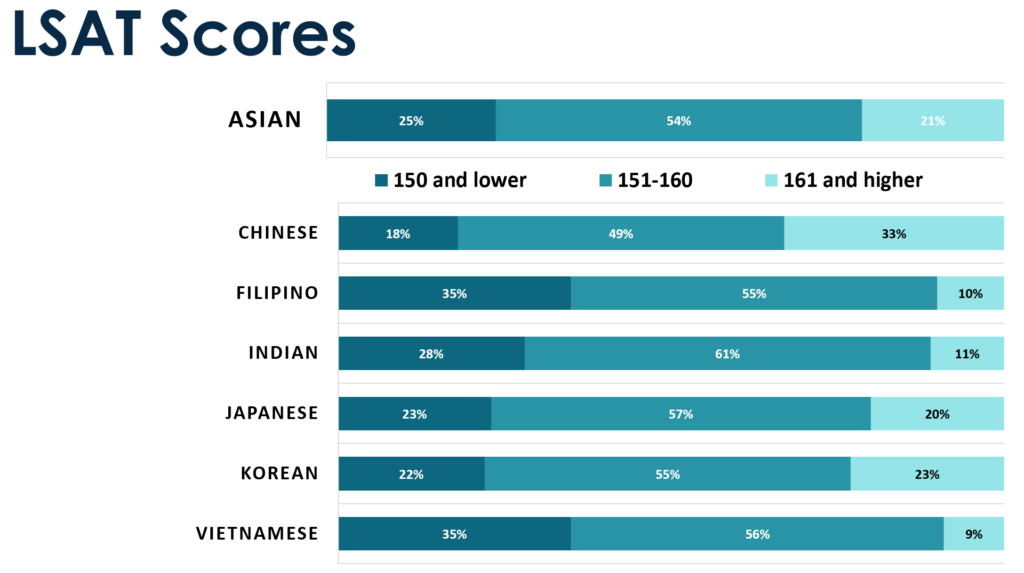
The differences between international and domestic students can also be significant. Students born and/or raised in the U.S. are often socialized very differently than those born and raised in their ancestral nations, and these two groups often have different backgrounds, outlooks, and experiences. Rather than grouping together all students descended of a particular ethnicity, it is informative to distinguish between international and domestic students for each ethnicity. This may be challenging in some circumstances, given the small samples for some ethnicities. In LSSSE’s 2016 survey, 50% of students of Chinese descent were international students, while only 1% of Filipino students were, and proportions of other AAPI subgroups identifying as international students varied widely: 24% Korean; 14% Asian Indian; 8% Vietnamese; and 7% Japanese. Depending on the questions being explored, it may be prudent to focus only on domestic students for some analyses and only on international students for others, and it may be necessary to combine the two for some purposes.
When analyzing the demographics and the academic and social experiences of AAPI students, higher education institutions should follow LSSSE’s lead and disaggregate different groups, and also distinguish between international and domestic students. There is no single, ideal way to classify all of the groups: that will depend on the question and analysis at hand. But paying attention to the nuances will help to dispel the stereotypes that AAPIs are “model minorities” and “perpetual foreigners”—stereotypes that lump different AAPI groups together. And while we can and should celebrate the heritage and contributions of AAPIs as a whole, understanding the nuanced differences between groups is what will truly address the challenges faced by various AAPI communities.
Guest Post: Assessment: How to Do It and How LSSSE Can Help
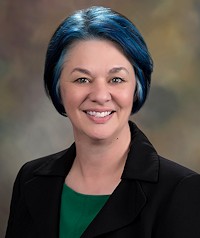 Assessment: How to Do It and How LSSSE Can Help
Assessment: How to Do It and How LSSSE Can Help
Emily Grant
Professor of Law
Washburn University School of Law
Psst. Have you heard? The American Bar Association (ABA) wants law schools to do assessment.
Of course you’ve heard. We all heard the call to assessment even before the relevant ABA standards (301, 302, 314, and 315) took effect in 2016.
Unlike some, however, I’ve drunk the assessment-flavored Kool-Aid, I’ve got the assessment tattoo,[1] and I’m bringing my flashlight back into the cave to help others with the assessment process. And luckily for all of us, LSSSE can play an important role in institutional assessment activities.
First up, what is assessment? At the most basic level, assessment is evaluation. It is the process of collecting data about student learning and using that data to improve teaching, learning, and indeed the full functioning of a law school.[2]
To that end, the ABA has mandated that a law school must establish a program of legal education and identify specific learning outcomes, or goals, that it is seeking to achieve (Standard 301). Those learning outcomes should include, at the very least, the topics listed in Standard 302, including the knowledge, skills, and values that law school graduates are to possess. The law school should use both formative and summative assessment methods[3] when evaluating students (Standard 314). And Standard 315 brings it all together: the law school administration and faculty “shall conduct ongoing evaluation” of the school and should use the results of that evaluation to make decisions about the future.
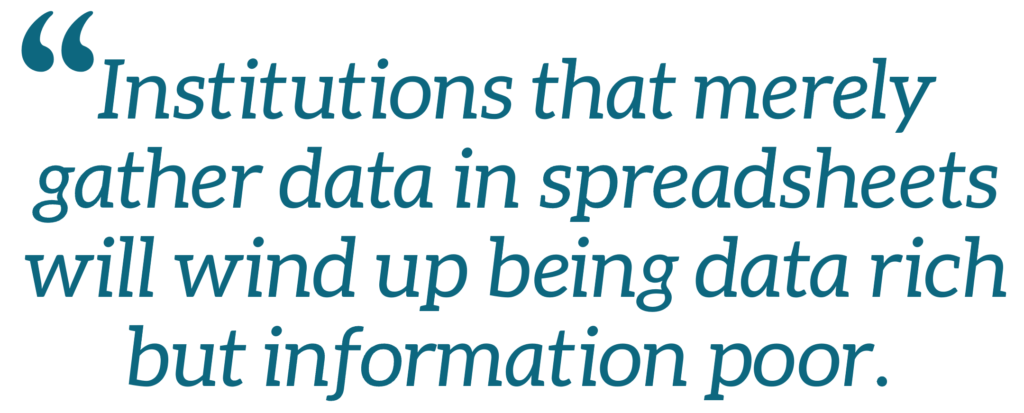
The process is designed to help law schools ensure that they, as institutions, are accomplishing their goals and that their students are taking away the things that are most important, as defined by each law school. Within the broad guidelines of the ABA noted above, law schools can prioritize certain knowledge, skills, and values—a social justice mission, for example, or specific professional competencies important to the institution. The assessment process can then expose weaknesses in the curriculum that might allow the important learning outcomes to fall through the cracks, and law schools can adjust accordingly. But the assessment process is also an opportunity for law schools to gather empirical evidence about their strengths and to continue and encourage curricular growth in those areas the students are learning and incorporating well.[4]
The assessment process needs to happen across various levels: institutions, programs or departments, and individual courses. The steps in the assessment process will generally be the same:
- Create student learning outcomes and ensure that the curriculum aligns with the outcomes.
- Design and administer assessment instruments to measure student achievement of those outcomes.
- Review and analyze data that assessment instruments produce.
- Make changes based on the data to improve student learning.
- Repeat the process to evaluate impact of the changes and whether they made any difference in student learning.
Assessment is a cyclical process; it’s iterative in that the data leads to information which can lead to changes in curriculum and instruction which produces new data to analyze. Institutions that merely gather data in spreadsheets will wind up being data rich but information poor. Instead, law schools must use the data “to determine whether they are delivering an effective educational program.”[5] The assessment process is meaningful only when schools use the data “to improve [themselves], to change the curriculum, to change teaching and learning methods, and even to change the assessment methods themselves.”[6]
LSSSE has been a model of effective data-use and frankly, serves as an entire warehouse of granular and big-picture data that law schools can access as part of the assessment process. For example, many law schools have already identified learning outcomes in areas such as knowledge of the law, effective research and writing, oral presentation skills, critical thinking, problem-solving, and professional ethics.
Check out the following questions on the LSSSE survey:
To what extent has your experience at your law school contributed to your knowledge, skills, and personal development in the following areas?
- Acquiring a broad legal education
- Acquiring job or work-related knowledge and skills
- Writing clearly and effectively
- Speaking clearly and effectively
- Thinking critically and analytically
- Using technology
- Developing legal research skills
- Working effectively with others
- Learning effectively on your own
- Understanding yourself
- Understanding people of other racial and ethnic backgrounds
- Solving complex real-world problems
- Developing clearer career goals
- Developing a personal code of values and ethics
- Contributing to the welfare of your community
- Developing a deepened sense of spirituality
That question alone is goldmine of information for law schools to methodically and quantitatively get feedback on the efficacy of the curriculum.
In total, about 60 items in the LSSSE survey map to the ABA standards and interpretations. All participating law schools receive an accreditation report, which could serve as another source of relevant data.
One of my professional roles is Co-Director of the Institute for Law Teaching and Learning, an organization of law school professors across the country (and beyond!) dedicated to improving… well… law teaching and learning. Because we recognize the value of the assessment process in strengthening legal education, we have recently released a comprehensive book discussing the assessment process in detail: Assessment of Teaching and Learning: A Comprehensive Guidebook for Law Schools by Kelly Terry, Gerald F. Hess, Emily Grant, Sandra Simpson (Carolina Academic Press 2021).
In the book, we explain that assessment in law schools can be viewed as a prism. Contained within the prism are principles and practices that apply to various aspects of legal education, including institutional assessment, programmatic assessment, and course-level assessment of student learning, as well as assessment of teaching effectiveness. The book is structured to be a resource in all of those areas. Specifically, it provides a thorough overview of the assessment process generally, and it includes a chapter about how to build a culture of assessment throughout the institution. Next, the book turns to the specifics of assessing student learning in a variety of contexts: at the institutional level, at the course level, and in the context of other programs in the law school, including experiential learning, legal writing, centers and concentrations, co-curricular activities, and non-academic units. Finally, the book focuses the assessment lens on teaching, with a discussion of the fundamentals and suggestions for both summative and formative assessment of teaching performance.
Using data from reliable and trusted sources, such as LSSSE, is important for law schools as they work to evaluate the effectiveness of their curricula. Data from LSSSE can be a valuable resource for law schools as they prepare for review by the ABA Accreditation process. In particular, LSSSE data can be central to a law school’s self-study and strategic planning process by providing focus and opportunities for follow-up. Moreover, LSSSE results are actionable; that is, they point to aspects of student and institutional performance that law schools can do something about. And that, after all, is the entire purpose of the assessment process.
----
[1] Not really, but how nerdy would that be?!
[2] Barbara E. Walvoord, Assessment Clear and Simple: A Practical Guide for Institutions, Departments, and General Education 2 (2010).
[3] Formative assessment is feedback provided during the course with the goal of improving students learning. Summative assessment evaluates student learning at the end of a particular course.
[4] Lori E. Shaw & Victoria L. VanZandt, Student Learning Outcomes and Law School Assessment: A Practical Guide to Measuring Institutional Effectiveness 32 (2015).
[5] Roy Stuckey et al., Best Practices for Legal Education: A Vision and a Road Map 272 (2007).
[6] Id. at 273.
Guest Post: Moving Legal Education to the Fourth Dimension
 Guest Post: Moving Legal Education to the Fourth Dimension
Guest Post: Moving Legal Education to the Fourth Dimension
Deborah Jones Merritt
Distinguished University Professor
John Deaver Drinko-Baker & Hostetler Chair in Law
Much of law school is two-dimensional, confined to the written pages of statutes, regulations, and appellate decisions. Clients appear in our classroom hypotheticals and final exams, but they are cardboard figures designed to illustrate a point or test a legal concept. These cut-out clients lack the backstories, personalities, and secrets that three-dimensional clients embody. Nor do these cardboard clients change their circumstances or modify their goals, as real clients do. While law school is two-dimensional, law practice spreads over all four dimensions of space and time.
How do new lawyers jump from two dimensions to four? Research I conducted with Logan Cornett, Director of Research at IAALS (the Institute for the Advancement of the American Legal System), suggests that the transition is difficult. Our research team conducted 50 focus groups with new lawyers and their supervisors to explore this transition. Our groups spanned 18 locations nationwide and included 200 demographically diverse lawyers. In addition to their demographic diversity, our focus group members represented a wide range of employment contexts: federal, state, and local government; nonprofits; firms of all sizes, and solo offices. They also worked in more than 50 distinct practice areas, ranging from animal rights to workers compensation.
These focus groups generated more than 1500 pages of transcribed comments, which we analyzed using standard tools of qualitative research. NVivo software helped us organize and code the data; we then followed the principles of grounded theory to draw insights directly from the data. The results overwhelmingly support four conclusions: (1) More than half of new lawyers engage directly with clients during their first year, often as early as the first week. (2) Many of these lawyers also take primary responsibility for client matters. (3) Although some employers offer careful supervision and training, many do not. Instead, many new lawyers operate solo—even when they receive a paycheck from an employer. (4) To practice effectively under these circumstances, new lawyers must possess twelve foundational competencies or “building blocks.”
We discuss these twelve building blocks at length in our report, Building a Better Bar: The Twelve Building Blocks of Minimum Competence. For quick reference, the blocks are:
- The ability to act professionally and in accordance with the rules of professional conduct
- An understanding of legal processes and sources of law
- An understanding of threshold concepts in many subjects
- The ability to interpret legal materials
- The ability to interact effectively with clients
- The ability to identify legal issues
- The ability to conduct research
- The ability to communicate as a lawyer
- The ability to see the “big picture” of client matters
- The ability to manage a law-related workload responsibly
- The ability to cope with the stresses of legal practice
- The ability to pursue self-directed learning
Even a quick glance suggests that many of these building blocks are three- and four-dimensional, rather than two-dimensional. New lawyers must act professionally, not just know the written rules of professional conduct. They must also counsel clients who live multi-faceted lives and who change their goals over time. Understanding legal processes, seeing the big picture of client matters, managing workloads, communicating as a lawyer, and coping with the stresses of legal practice are all three- and four-dimensional tasks.
Law schools have made significant progress in teaching students to navigate the complex dimensions of law practice: Clinics and other experiential offerings have expanded over the last 20 years. In LSSSE’s most recent survey, two-thirds of law students reported that their legal education helped them either “very much” or “quite a bit” to acquire job-related knowledge and skills. Sixty percent expressed similar appreciation of law school’s contribution to learning how to solve “complex real-world problems.”
But the LSSSE survey also points to areas of needed improvement. Only about half of respondents believed that law school had helped them “very much” or “quite a bit” in understanding people of other racial and ethnic backgrounds, developing clear career goals, shaping a personal code of values and ethics, or working effectively with others. Although phrased differently than our twelve building blocks, these competencies relate to the complex skills we identified in our research.

Once the LSSSE respondents enter practice, moreover, they may be less sanguine about their preparation. Many new lawyers in our focus groups told us that their first year of practice was a “trial by fire.” They struggled to counsel clients, develop strategies, and resolve matters with little supervision. Once on the job, they discovered that they needed more job-related skills than law school provided. Why, they asked, didn’t law school better prepare them for the full range of their work?
Legal educators often say that employers are better suited than professors to teach advanced practice skills. Law school, they argue, properly focuses on teaching basic skills (such as case analysis), threshold concepts, and detailed doctrine. But our research partially disputes that claim. New lawyers undoubtedly need the basic skills and threshold concepts that law school instills. But once they possess those competencies, employers are quite capable of teaching junior lawyers specialized doctrine. Indeed, many new lawyers practice in fields that they never studied. In contrast, employers lack both time and expertise to teach advanced skills like counseling clients, gathering relevant facts, and negotiating with adversaries.
Law school is the place to learn these complex skills. Clinicians and other skills professors know how to teach cognitive skills like counseling, fact gathering, and negotiating. They also know how to provide feedback to novices and coach them to competence. Workplaces offer opportunities to hone professional skills, but schools are the best place to learn the basics.
Some lawyers think of counseling, fact gathering, and negotiating as soft skills that can’t be taught. But there’s nothing soft or unteachable about these skills. They’re harder to teach than the skills we teach in the first-year curriculum, but they’re quite teachable. Think of these skills as the second stage of learning to think like a lawyer. First-year students learn how to analyze legal materials, synthesize those materials, and apply legal rules to hypothetical problems. Those skills lay a foundation for learning more complex skills like counseling, fact gathering, and negotiating. The latter skills require students to add multi-dimensional clients, uncertain legal processes, and shifting fact patterns to their two-dimensional analyses.
If we want our graduates to serve clients effectively, law schools must step into the fourth dimension. Before graduation, every student should learn to counsel clients, gather facts, negotiate, and perform the other multi-dimensional skills embodied in the twelve building blocks listed above. The LSSSE survey can help us continue to track progress on that essential front.
The word "impotence" is considered outdated and is rarely used in modern medical sources. It is used when more than 75% of attempts to get an erection during sexual intercourse end in failure. A more https://www.faastpharmacy.com/ accurate and modern term is "erectile dysfunction", which describes a variety of problems in bed in young and mature men.
Guest Post: Legal Education and the Illusion of Inclusion
Guest Post: Legal Education and the Illusion of Inclusion
 Shaun Ossei-Owusu
Shaun Ossei-Owusu
Presidential Assistant Professor of Law
University of Pennsylvania Carey Law School
A new semester and a potentially new political landscape are upon us. Last month law students around the country resumed coursework. Their educational pursuits are virtual, in-person, or some mix of both. No matter the format, law students continue their educational journey in an ideologically polarized pandemic society where race, class, and gender disparities are on sharp display.
Students will also be learning in a context where changes in our legal system may have direct relevance to their legal education. As is typically the case, a newly constituted Supreme Court has a diverse docket this term that might shape substantive areas of law that students take courses in, chiefly constitutional law. There will be regulatory shifts that come with new administrations. These kinds of changes will have meaning for administrative law and related areas of law: health law, environmental law, employment law, and civil rights, to name a few. COVID-19 has upended state and federal judiciary systems in ways that have still-undetermined implications for procedural courses law students take (e.g., evidence, civil procedure, criminal procedure) and access to justice issues more generally. And we know from the late Deborah Rhode’s work which communities access to justice issues tend to devastate—racial minorities, women, and other marginalized populations.
Notwithstanding future uncertainty, one thing can be said with some measure of confidence: issues of race and gender—amongst other social categories—will remain relevant inside and outside the sometimes intellectually-cordoned off walls of law schools. How these issues are integrated in the classroom, if they are at all, will affect the substantive learning of law and will either include or exclude historically marginalized groups.
In the specific context of legal education, the results of Law School Survey of Student Engagement’s (LSSSE) Annual Survey illuminate. The Report provides a glimpse into how law schools fail to meet the aspirational goal of inclusion that often takes up primetime real estate on their websites and promotional materials. From my own read, the most jaw-dropping finding is intersectional in nature and about Black and Latinx women law students—aspiring attorneys who are often told that they do not look like lawyers when they transition to practice. 26% of Black women respondents and 17% of Latinx women respondents reported that their schools do “very little” to support racial and ethnic diversity.
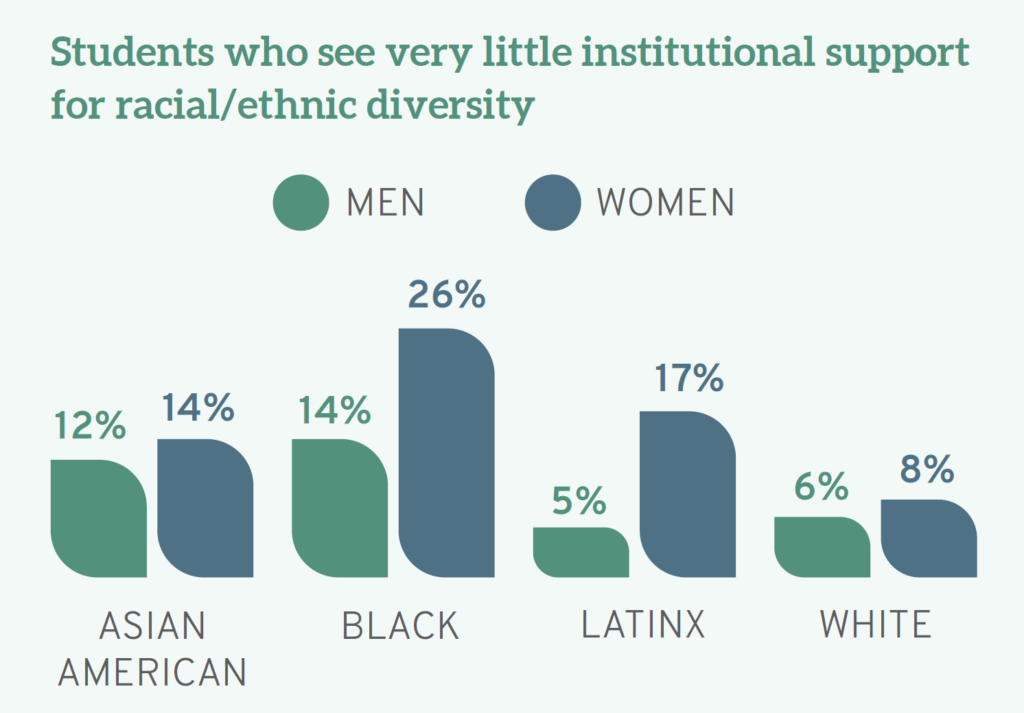
Disenchantment with the lack of support for diversity can be distilled even further. The Report notes that men varied on the issue of gender inclusivity, with 39% “very much” believing that their schools support gender diversity compared to 27% of women and 9% of individuals who identified with the “other gender” category.
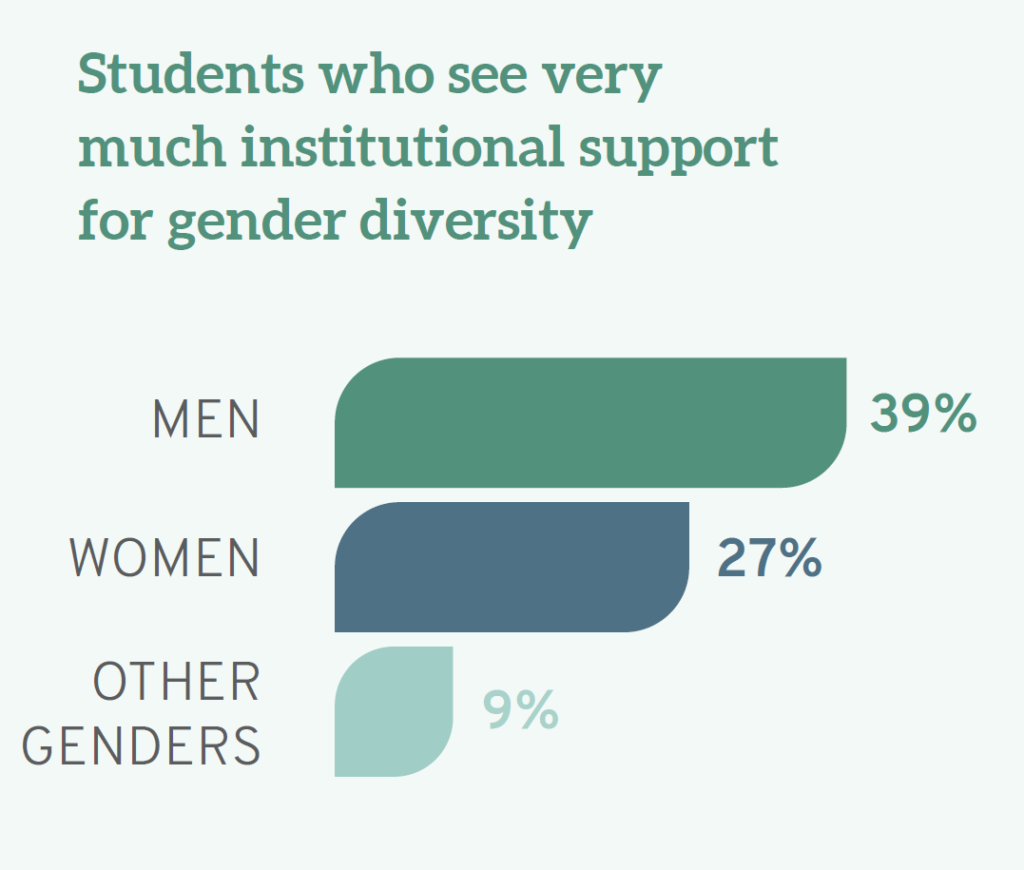
In the context of race, student views also differed, with 9% of White students, 14% of Native American students, 18% of Latinx students, and 25% of Black students believing that their schools do “very little” to ensure that students are not stigmatized based on identity.

Where sexuality and sexual orientation are concerned, 11% of heterosexual students think their schools do only “very little” to avoid identity-based stigma; conversely, 20% of gay students, 16% of lesbian students, 15% of bisexual students, and 19% of those who identify as another sexual orientation see their schools as doing “very little” in this regard. What do these findings mean for legal education and the political moment I gestured to in the beginning?
LSSSE’s data suggest that some students are dissatisfied with the six-figure education they are receiving. Put plainly, law students from backgrounds that the profession has historically excluded—women, racial minorities, LGBTQ communities, and people with disabilities in particular—do not feel part of the academic community and believe law schools are relatively disinterested in their stigmatization. In some ways, this is unsurprising, as there is a deep scholarly literature and genre of books on student disappointment with law school. Moreover, student disenchantment with legal education—which has a history of exclusion that traces back to the nativism and anti-Semitism of the early twentieth century—may in some ways be pre-determined.
The confines of the classroom, which is one of the many areas the LSSSE survey discusses, provides more insight into the inclusion-exclusion dyad. From the vantage point of some educators, law school is simply about training people to be lawyers. The most generous reading of this position suggests that social justice-like ideas like “inclusion” are too ideologically weighty to meaningfully bring in the classroom. For people who subscribe to this view, attempts at inclusion can create impossible-to-navigate landmines for professors. More skeptically, some see inclusion as an ancillary. Read in this light, the primary goal is to inculcate legal knowledge. For these professors, some things are not relevant to the practice of law and are therefore not relevant to legal education.
Such professional school-based views of legal education, vary in their reasonableness, but are held by swaths of the professoriate. Yet, there is a two-fold problem, and this is where the LSSSE survey is especially useful. First, this vision of legal education rubs up quite abrasively against the representations of law schools as bastions of inclusion. Second, this version of education, in some ways, undermines the well-touted “diversity rationale” in affirmative action jurisprudence. What does diversity mean when the subjects of diversity feel alienated?
Considering the mismatch between some students’ experiences and the stricter professional school model of legal education that some professors are beholden to, there are some options. Educators can simply be more intellectually honest about the reality that law school is a site of professionalization where inclusion principles can be trivialized. Alternatively, law schools can continue to disingenuously hitch the law school wagon to social justice rhetoric while failing to actualize inclusion as a practice. Or, in the most courageous and imaginative versions of themselves, law schools can refashion their curriculum and use developments in the legal world as opportunities to offer more inclusive learning environments.
For law schools committed to the third way, resources abound. Complaints about the need to diversify the content of law school courses have existed for decades. Scholars such as Derrick Bell and Dorothy Brown have authored casebooks that describe how race intersects with different areas of the legal curriculum, whereas feminist legal theorists, poverty researchers, scholars of law and sexuality have penned their own books, supplements, and articles that all give educational guidance on how to bring these issues into core courses, and do so in ways that are doctrinally sound. Still, some professors—many of whom have the most analytically sharp minds on their university campuses—throw their hands up in despair or continue with the same regularly scheduled program. For some of these instructors, these conversations were absent in their legal education, and they were likely not trained to incorporate these issues. Some may think it would be better to leave this work of thematic inclusion to their more expert colleagues (e.g., scholars of race, sex, class, disability) rather than wade into territory where they are sure to mess up. But throwing one's hands up in despair is increasingly a less credible course of action. The pandemic, along with the protests of 2020, have forced some people to rethink how they deliver course content, and more importantly, have made inequality a more prominent theme in our public discourse. The current socio-political moment, and the reality of pandemic pedagogy, call for curricular redesign.
Fortunately, the tools to make the classroom more inclusive are available and they are not limited to the usual courses. To be sure, law professors have written about how first-year courses like criminal law and property are inattentive to inequality in ways that produce the responses found in the LSSSE survey and have offered suggestions on how those same courses could easily be improved. But attempts to diversify and create a more inclusive curriculum are not confined to these foreseeable areas of law but can be found in more unsuspecting places like evidence, corporate law, trust and estates, and intellectual property, to name a few.
Law professors have also identified space in the curriculum for trans-substantive engagement with the kinds of questions and perspectives that demonstrate an awareness of inequality, both in legal education and in law more generally. Indeed, I, along with my colleague Karen Tani, have taken on the task of trying to simultaneously create an inclusive learning environment that rigorously addresses inequality by creating a 50-person Law and Inequality course at Penn Law. This endeavor and more meaningful engagements with diversity need not be limited to women, racial minorities, and sexual minorities. Inclusion also implicates and has meaning for the larger law student population. One of the most understated findings in the LSSSE Report is that 16 percent of white students believed law schools placed “very little” emphasis on issues of equity and privilege and do not prioritize providing students with the skills necessary to confront discrimination and harassment.
My purpose here is not to proselytize teaching a course like the one we are offering. Instead, I want to highlight how student dissatisfaction with inclusion, which the Report highlights in detailed and accessible fashion, can be situated within this critical juncture. 2021 is a unique moment where law schools can reimagine legal education in real time, and for a post-pandemic world. This will not be easy, as this is a stressful time for faculty—some of whom are in high-risk groups during the pandemic and/or have a variety of care obligations. COVID-19 has upended a lot of assumptions and forced people to change longstanding pedagogical practices. Institutions could do a lot of good by encouraging faculty reflection and supporting creative reorganization of current courses.
The LSSSE Report tells us that in many ways, law schools are failing to provide the inclusive educational spaces that they, I believe in good faith, want to offer and that students of various backgrounds actively desire. Ultimately, the teaching tools are available, the moment is ripe, and the only outstanding question is whether legal educators will make the changes necessary so that the next LSSSE survey offers more optimistic findings.







